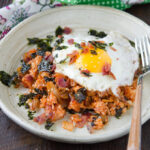
Kimchi Fried Rice with Bacon (Kimchi Bokkeumbap)
A quick and flavorful kimchi fried rice made with crispy bacon, ripe kimchi, and cold leftover rice. A cozy Korean 25-minute skillet meal.
Ingredients
- 1 1/2 cups (360 g) fermented sour cabbage kimchi chopped
- 1/2 (about 80 g) onion chopped
- 4-6 bacon strips chopped
- 2-3 tbsp (30–45 ml) kimchi juice
- 3 cups (600 g) cooked rice
- 2 tsp (12 g) Korean chili paste (gochujang) see note below for gluten-free option
- 2 tsp (10 ml) sesame oil
- 2 tsp (6 g) toasted sesame seeds
- salt and pepper to taste
- 1 package (3–5 g) roasted seaweed crumbled
- 4 eggs fried sunny side up
Instructions
- In a heavy skillet, cook bacon pieces until crisp. Transfer the bacon to a platter, and set aside. Using a paper towel, wipe off the bacon grease remained in the skillet but leave 1 tablespoonful.
- Saute onion in the reserved bacon grease until soft and tender over medium heat. Add the kimchi and continue to saute until kimchi is soft, about 5 minutes over medium-low heat, then add Korean chili paste and kimchi juice to the skillet and mix well to incorporate with kimchi and onion.
- Add the rice to the mixture and toss well. Use the edge of a spatula to separate the rice grains without smashing them.
- Add sesame oil and sesame seeds, and toss well. Season with salt and pepper as you wish.
- Raise the heat to medium heat and let the fried rice to sear for 2-3 minutes. This will help the rice on the bottom of skillet to be crisp. Adjust the heat, if needed, so that you don't burn it too much. Check the bottom of the fried rice to see it created desired crispness on the rice.
- Remove the skillet from the heat and sprinkle with the reserved bacon pieces and crumbled roasted seaweed. To serve, add sunny side up fried eggs on top. Enjoy while hot!
Video
Notes
Vegetarian option: Replace the bacon with sautéed mushrooms or pan-fried firm tofu. Both absorb the kimchi flavor well and still give great texture.
Gluten-free: Use a certified gluten-free gochujang brand. Ingredient labels vary, so double-check the packaging.
Saltiness varies: Kimchi and gochujang differ by brand and fermentation level. Taste at the end and adjust with a pinch of salt, sugar, or gochugaru if needed.
Nutrition
Calories: 341kcal | Carbohydrates: 36g | Protein: 12g | Fat: 16g | Saturated Fat: 5g | Polyunsaturated Fat: 3g | Monounsaturated Fat: 7g | Trans Fat: 1g | Cholesterol: 178mg | Sodium: 211mg | Potassium: 184mg | Fiber: 1g | Sugar: 1g | Vitamin A: 316IU | Vitamin C: 2mg | Calcium: 52mg | Iron: 1mg